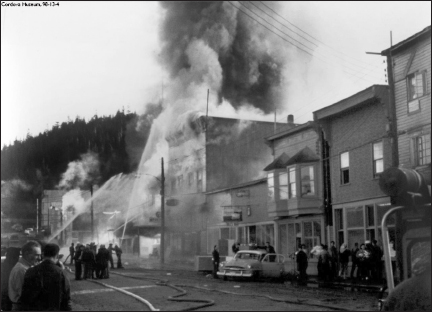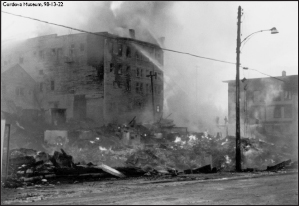SOME LOW POINTS
33
CORDOVA BURNS
Fire plagued many towns in Alaska when wooden structures were heated and illuminated by woodstoves and lanterns. One errant spark or flame could spell disaster. And such was the fate for one quaint little town in Prince William Sound in the early 1960s.
Cordova had seen and survived several fires since its difficult birth in the early 1900s when the discovery of copper led to a railroad connecting it to the Kennecott copper mines. And it lived through a boisterous childhood and stormy adolescence when a few fires destroyed several homes and businesses.
By the 1930s, Cordova had matured and settled down into a modern, prosperous town with a stable population, schools, churches, theater, numerous social clubs, two banks, a library and every type of business.
An almost fatal nonfire blow came in 1938 when the Kennecott copper mines closed down. The railroad was abandoned, the rails sold for scrap and ghost towns were left scattered along the 200-mile right of way.
But although betrayed by copper, Cordova had another resource to fall back on – the silver of the sea. So fishing and canning fish, clams and crab provided employment for the people who stayed with the town. The population did decline, but Cordova lived on.

A devastating fire swept through Cordova’s business district on May 2, 1963.
Then, on May 2, 1963, it faced one of its greatest challenges. Cordova’s residents awoke in the early hours to find a major fire sweeping through their town.
It started in the Club Café in the Van Brocklin Building and quickly spread through the Club Bar and Cordova Commercial Co. on the corner of First and Council streets, according to Cordova historian Dixie Lambert. Then it jumped to the Donohoe Building, which housed the Cordova Airlines office, Hosick’s Tavern and the Cordova Beauty Salon.
The fire swept unchecked to the south and consumed everything in its path.
“C.T. Davis & Sons Grocery, Bill and Edna Reid’s Little Bar and Myra McDonald’s Cordova Drug Store with the Elks Lodge on the second floor fueled the flames,” Lambert said.
Cordovans awoke at 4 a.m. that day to the chilling wail of fire sirens rushing through their streets. Then they heard a bombardment of ammunition as shells exploded.
“In a desperate attempt to stop the fire, dynamite was used to blow up Bill’s Bar, owned by Bill and Katherine Hall,” Lambert said.
Firemen had used the practice of lighting dynamite in burning buildings in the past to stop the spread of fire, but the strategy did not work this time. The six charges of dynamite only added to the confusion.
“The explosion blew out windows all along First Street but did not stop the advancing flames,” Lambert said.
Soon more businesses were ablaze, including Cliff Collin’s Jewelry, Cordova Bakery, Lucille Discher’s Variety Shop, Pete and Lilly Lovseth’s Magazine and Notions Store, Eunice Flinn’s Mens Wear and Sporting Goods and the Cordova Insurance office rented by Harold Nordman.
“Soon every store from Browning to Council was engulfed in spectacular flames,” Lambert said. “The fire continued its relentless march by jumping up to Mae Jones’ apartment house on Second Street.”

Cordova Commercial burned, as well as Club and Davis’ Superfoods on Main Street.
The fire then raged through Harold Bosner’s building, which housed The Cordova Times, and on to Karl Barth’s hardware store in the Central Building. Service Transfer’s warehouse in the alley and the Van Brocklin apartment building on the corner of Council and Second streets also fell victim to the blaze. The only building left standing on that block was the Club Bowl, a concrete block building with a sprinkler system that kept its roof watered.
The fire did not stop until 14 downtown buildings had been destroyed and many more damaged, including City Hall, the fire department, Cordova Cleaners and First Bank of Cordova.
A little farther away, the Harbor House, the Northern Hotel, the Alaskan Hotel and the Cordova Hotel sustained damage, too. The destruction left more than 125 men, women and children homeless.
At the height of the excitement, everyone was too busy to feel the full impact of the catastrophe. Victims even joked with one another as they staggered out of fire-threatened apartments and stores under huge loads of clothing, bedding, furniture, household goods, gill nets, outboard motors and merchandise. They were relieved that no one had been seriously injured and could even see humor as the whole area around the fire began to look like a huge secondhand store.
“Where’s the hot dogs?” one humorist shouted as the flames blazed higher.
Cordova residents helped their volunteer firefighters as did crews from the U.S. Coast Guard cutters Sedge and Sorrell. A Federal Aviation Association fire crew brought their equipment from Mile 13, too.
More help poured into the town when the U.S. Air Force sent a 20,000-gallon pumper, a 7,000-gallon pickup fire truck and a seven-man firefighting team to Cordova on a military air transport service C-124. The Bureau of Land Management sent more equipment and volunteer firefighters from Anchorage on a C-124, as well, and a Civil Defense firefighting jeep from Seward and a shipment of insulin came in on a C-123.
At noon that day, Cordovans gazed at the blackened ruins of what had been a thriving downtown – almost the entire business district was gone.

The fire on May 2, 1963, destroyed most of Main Street Cordova. This photo shows foundations still burning hours later.
By 12:30 p.m., with the fire under control, reaction set in. The tired, lined faces of Cordova’s weary citizens showed that they now realized their loss. They also realized that if they were to survive this blow, they faced the fight of their lives.
“Cordova was declared a disaster area and the Small Business Bureau helped arrange loans to the business people to rebuild,” Lambert said.
She added that the American Red Cross and The Salvation Army offered assistance to the displaced residents. The Alaska Railroad sped supplies from Anchorage to Seward and the Alaska Steamship Co. transported them to Cordova on board the steamship Iliamna at no charge.
Those from other towns donated clothing and household goods that were flown into Cordova from Kodiak, Juneau and Anchorage. The Alaska Communications System donated telephone equipment, too, which was installed by FAA and Civil Defense personnel.
The disaster only made the people of Cordova stronger. Instead of the death of the “Stout-hearted City,” as Alaska’s Sen. E.L. “Bob” Bartlett once called Cordova, the disastrous fire meant a rebirth.
Townspeople pitched in, and in a short time they had cleared all the debris and began rebuilding. Within a week, most businessmen were back in business in temporary spaces in buildings that had escaped the inferno.
Harold Bonser, owner of The Cordova Times, put his weekly paper out on schedule, although it was mimeographed at the Red Dragon saloon because his press and linotype had been destroyed.
“He kept everyone abreast of the new locations for the downtown businesses and the rebuilding progress,” Lambert said.
The pioneer grocery firm of C.T. Davis & Sons began selling groceries out of its concrete block warehouse, which survived the fire. Cordova Airlines started working out of the First Bank of Cordova, across the street from the ruins of its downtown office.
Help poured into the city from all over the state. A chartered plane filled with 27 business, civic and labor leaders flew in from Anchorage the day after the fire and offered their assistance – from banking services to the skilled muscles of organized labor.
State, federal and private agencies also cooperated, but Cordova’s citizens didn’t sit back expecting others to pull them through. They didn’t waste any time feeling sorry for themselves. By their own efforts, they took care of everyone displaced by the fire.
“In fact,” local Civil Defense leaders reported, “we had 104 more offers of temporary housing than we needed.”
Gov. William A. Egan, in Cordova a few days after the fire, told its residents: “Because of your loss, I wasn’t looking forward to this trip, but I find you are already planning ahead. I am pleased you are thinking of the future and not of the past.”
With the spirit and enthusiasm of pioneers past, Cordova’s citizens knuckled down and rebuilt their town. But this time they used different building materials – concrete block buildings replaced wooden frames.
While the 1963 fire was one of the worst economic disasters to hit Cordova since its birth, Lambert said “the generous spirit and can-do attitude of Cordovans pulled the town through the ordeal.”
Another group of Alaskans also had to dig deep and find their can-do attitude four years later when a devastating flood destroyed many of their homes and businesses in the state’s Interior.